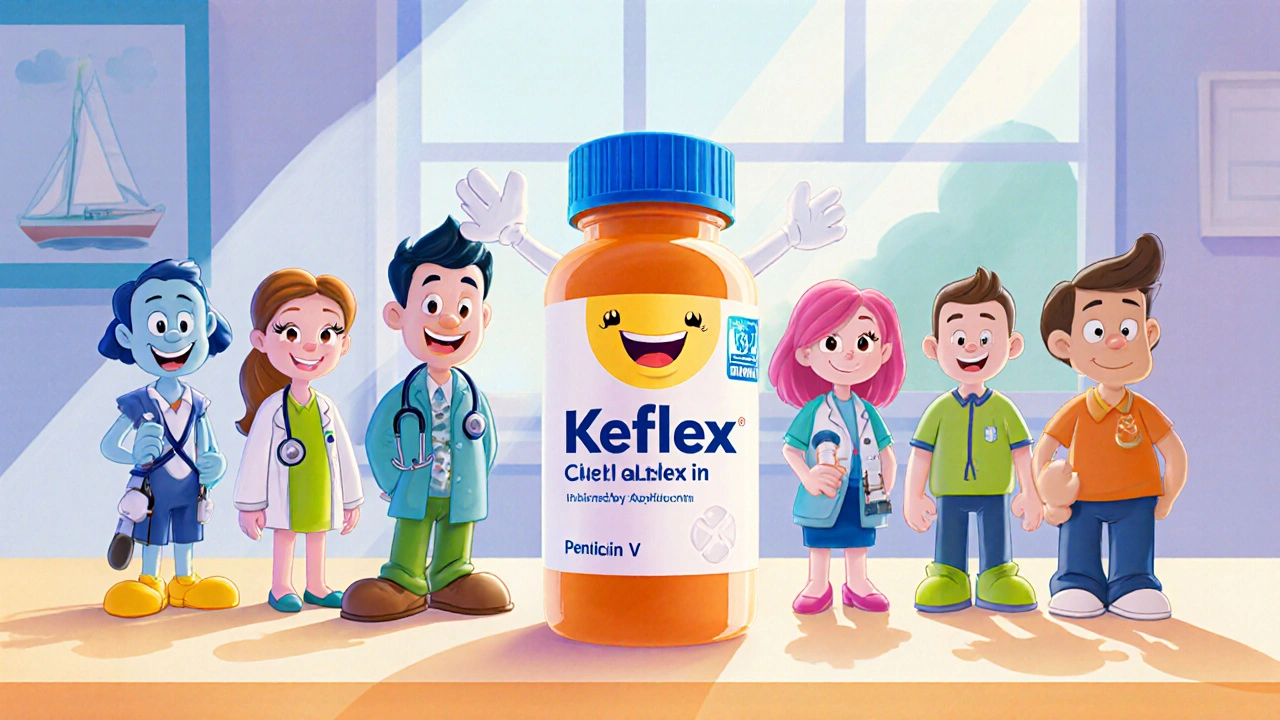Key Takeaways
- Keflex (Cephalexin) is a first‑generation cephalosporin ideal for uncomplicated skin and soft‑tissue infections.
- Amoxicillin and Penicillin V excel in treating many upper‑respiratory infections but face higher resistance in some regions.
- Clindamycin offers strong coverage against anaerobes and MRSA, though it carries a higher risk of Clostridioides difficile.
- Azithromycin provides convenient once‑daily dosing and good intracellular penetration, useful for atypical pathogens.
- Levofloxacin and Bactrim are broad‑spectrum agents reserved for cases where first‑line drugs fail.
What Is Keflex (Cephalexin)?
When you hear the name Keflex is the brand name for Cephalexin, a first‑generation cephalosporin antibiotic that interferes with bacterial cell‑wall synthesis. It is taken orally, usually every 6‑8 hours, and is FDA‑approved for skin infections, urinary tract infections, and uncomplicated dental infections.
Cephalexin’s chemical structure gives it solid activity against many Gram‑positive organisms (Staphylococcus aureus, Streptococcus pyogenes) while retaining modest Gram‑negative coverage (E. coli, Klebsiella). Because it is excreted unchanged in urine, dosing adjustments are simple for patients with renal impairment.
Common Oral Antibiotic Alternatives
Below are the most frequently prescribed oral antibiotics that clinicians consider when Keflex isn’t the best fit.
- Amoxicillin - a broad‑spectrum penicillin useful for otitis media, sinusitis, and community‑acquired pneumonia.
- Penicillin V - narrow‑spectrum penicillin mainly for streptococcal pharyngitis and mild skin infections.
- Dicloxacillin - a penicillinase‑resistant penicillin targeting MSSA skin infections.
- Clindamycin - covers anaerobes and MRSA, often used for dental abscesses and deep skin infections.
- Azithromycin - a macrolide with a long half‑life, good for atypical pneumonia and chlamydia.
- Trimethoprim‑Sulfamethoxazole (Bactrim) - a sulfonamide combo active against many Gram‑negative and some MRSA strains.
- Levofloxacin - a fluoroquinolone with broad coverage, reserved for complicated infections.

How Do They Stack Up? Comparison Table
| Antibiotic | Spectrum | Typical Use Cases | Dosing Frequency | Common Side Effects | Resistance Concerns |
|---|---|---|---|---|---|
| Keflex (Cephalexin) | Gram‑positive >, limited Gram‑negative | Skin/soft‑tissue, uncomplicated UTIs | Every 6‑8 h | Diarrhea, nausea, rash | Increasing ESBL‑producing E. coli |
| Amoxicillin | Broad Gram‑positive & Gram‑negative | Otitis media, sinusitis, pneumonia | Every 8 h | Diarrhea, allergic reactions | β‑lactamase producing H. influenzae |
| Penicillin V | Gram‑positive (streptococci) | Strep throat, mild skin infections | Every 6‑8 h | Allergic rash, GI upset | Rare for streptococci |
| Dicloxacillin | Penicillin‑resistant Staph (MSSA) | Cellulitis, impetigo | Every 6 h | Hepatotoxicity, GI upset | MRSA not covered |
| Clindamycin | Anaerobes, MRSA | Dental abscess, deep tissue infections | Every 6‑8 h | Clostridioides difficile, nausea | Increasing clindamycin‑resistant anaerobes |
| Azithromycin | Gram‑positive, atypicals, some Gram‑negative | Atypical pneumonia, chlamydia, traveler's diarrhea | Once daily (5‑day course) | QT prolongation, GI upset | High macrolide resistance in S. pneumoniae |
| Trimethoprim‑Sulfamethoxazole (Bactrim) | Broad Gram‑negative, some MRSA | UTIs, skin abscesses, PCP prophylaxis | Every 12 h | Photosensitivity, hyperkalemia | Resistance in many Enterobacteriaceae |
| Levofloxacin | Very broad (Gram‑+, Gram‑‑, atypicals) | Complicated UTIs, COPD exacerbations | Once daily | Tendonitis, QT prolongation, CNS effects | Emerging fluoroquinolone resistance |
When Is Keflex the Right Choice?
If you have a confirmed or highly probable infection caused by susceptible Gram‑positive bacteria-think of a simple cellulitis after a minor cut-Keflex is often first‑line. Its safety profile is solid, it doesn’t require food restrictions, and the twice‑daily dosing (or three times for severe infections) fits most schedules.
Patients with a known penicillin allergy can usually tolerate cephalosporins like cephalexin, provided the reaction wasn’t an anaphylaxis. However, if you have a history of severe cephalosporin allergy, switch to a macrolide or a fluoroquinolone after sensitivity testing.
Renal dosage adjustment is essential for elderly patients or those with chronic kidney disease. A typical adjustment reduces the total daily dose by 50 % when creatinine clearance drops below 30 mL/min.
Choosing an Alternative - Decision Guide
- Identify the likely pathogen. Skin‑and‑soft‑tissue infections are usually Gram‑positive; respiratory infections can be mixed.
- Check local resistance patterns. Many regions report rising ESBL‑producing E. coli, which makes cefalexin less reliable for UTIs.
- Consider patient‑specific factors. Allergy history, pregnancy, renal/hepatic function, and drug‑interaction profile matter.
- Match dosing convenience to adherence. Once‑daily azithromycin or levofloxacin improves compliance, but weigh the higher risk of serious side effects.
- Reserve broad‑spectrum agents. Use levofloxacin or Bactrim only when culture & sensitivity dictate, to curb resistance.

Side Effects & Drug Interactions to Watch
All antibiotics carry some risk of GI upset, but each class has signature cautions.
- Keflex: Rarely causes hepatotoxicity; avoid concurrent high‑dose probenecid which can raise serum levels.
- Amoxicillin: May reduce efficacy of oral contraceptives-advise backup contraception.
- Clindamycin: Strong association with C. difficile colitis; use only when benefits outweigh risk.
- Azithromycin: Interacts with drugs that prolong QT (e.g., sotalol); monitor cardiac patients.
- Levofloxacin: Increases risk of tendon rupture, especially in older adults on corticosteroids.
Frequently Asked Questions
Can I take Keflex if I’m allergic to penicillin?
Most people with a mild penicillin allergy tolerate cephalosporins like cephalexin. If you’ve ever had anaphylaxis, choose a non‑β‑lactam alternative such as azithromycin or clindamycin after consulting your doctor.
Why is a 5‑day azithromycin course often preferred over a 10‑day amoxicillin regimen?
Azithromycin’s long half‑life allows once‑daily dosing and a shorter total treatment period, which improves adherence. However, rising macrolide resistance limits its use for common streptococcal infections.
Is it safe to use Keflex during pregnancy?
Cephalexin is classified as Pregnancy Category B (US) - animal studies show no risk, and human data are reassuring. It’s commonly prescribed for uncomplicated infections in pregnant women when needed.
When should I switch from Keflex to a broader‑spectrum antibiotic?
If the infection worsens after 48‑72 hours despite appropriate dosing, or if culture results show a resistant organism, escalating to a broader agent like levofloxacin or Bactrim is reasonable.
How does renal function affect Cefalexin dosing?
For creatinine clearance < 30 mL/min, halve the usual dose or extend the dosing interval. This prevents drug accumulation and reduces the risk of neurotoxicity.
Bottom Line
Choosing the right oral antibiotic is a balance between the likely bug, patient factors, and local resistance trends. Keflex shines for uncomplicated Gram‑positive skin infections and many urinary infections, but alternatives like amoxicillin, clindamycin, or azithromycin may be better suited for respiratory, anaerobic, or atypical pathogens. Always involve a healthcare professional to interpret cultures, allergies, and comorbidities before starting therapy.

Comments
Victor T. Johnson
Keflex is fine but honestly we're overusing antibiotics like candy these days. My cousin got prescribed it for a cold. 🤦♂️
On October 25, 2025 AT 15:25
Nicholas Swiontek
This is such a clear breakdown! I wish more doctors gave this kind of info instead of just handing out scripts. 👏
On October 26, 2025 AT 09:56
Robert Asel
The assertion that cephalexin is 'ideal' for skin infections is empirically unsound. One must consider regional resistance profiles, which are not adequately contextualized in this piece. Furthermore, the omission of pharmacokinetic variability across age cohorts constitutes a significant clinical oversight.
On October 27, 2025 AT 11:43
Shannon Wright
I've seen so many patients get stuck on antibiotics because they don't understand when to stop or when to switch. This guide is a game-changer for patient education. Seriously, print this out and hand it to everyone you're prescribing to. We need more clarity like this in primary care.
On October 28, 2025 AT 12:14
vanessa parapar
Keflex? That's so 2010. Everyone knows clindamycin is the real MVP now, especially with all the MRSA floating around. You're doing your patients a disservice if you're still defaulting to cephalexin.
On October 29, 2025 AT 06:13
Ben Wood
I'm not saying this is wrong, but... have you considered that maybe the entire antibiotic model is flawed? We're just playing whack-a-mole with bacteria. Evolution doesn't care about your prescription pad. And why do we still use 'broad-spectrum' like it's a badge of honor? It's not a superhero power. It's a last resort.
On October 30, 2025 AT 13:27
Sakthi s
Good summary. Simple and useful.
On October 30, 2025 AT 13:40
Rachel Nimmons
I don't trust any of this. Big Pharma wrote this. They're hiding the truth about gut damage and long-term immune collapse. You think your UTI is bad? Wait till your microbiome is a wasteland at 40.
On November 1, 2025 AT 12:38
Abhi Yadav
Antibiotics are just a band-aid on a system that's rotting from within. We treat symptoms, not the soul's imbalance. 🌿 Maybe your infection is your body screaming for stillness. Have you meditated today?
On November 3, 2025 AT 00:43
Julia Jakob
Keflex is fine but honestly i just use amoxicillin for everything and it works. who even cares about the table? i'm not a doctor lol
On November 4, 2025 AT 07:27
Robert Altmannshofer
Man, I used to be the guy who'd pop antibiotics like candy after a cut or a scratch. Then I got C. diff after a simple sinus infection on clindamycin. That was hell. Now I wait. I ice it. I drink ginger tea. I let my body fight. Only if it's raging after 72 hours do I even think about a script. This table? Lifesaver. Seriously.
On November 5, 2025 AT 03:25
Kathleen Koopman
I love that you included the dosing frequency! I always forget how often I’m supposed to take stuff 😅
On November 5, 2025 AT 20:51
Nancy M
In India, we often use cephalexin for uncomplicated UTIs because it's cheap and accessible. But resistance is climbing fast. We need better diagnostics before we prescribe. Education matters more than antibiotics.
On November 6, 2025 AT 00:02
gladys morante
I hate how doctors just throw antibiotics at everything. My last one gave me Keflex for a rash that turned out to be poison ivy. I spent three weeks on it. Now I just use aloe vera and cry.
On November 7, 2025 AT 13:53
Precious Angel
You think this is the whole story? They don't tell you that antibiotics are used to control populations. The CDC is lying. The microbiome is a weapon. You think your 'uncomplicated UTI' is just a bug? No. It's a trigger. They want you dependent. They want you docile. Read the fine print on the bottle. It's not medicine. It's control.
On November 8, 2025 AT 15:12
Melania Dellavega
I’ve been on so many antibiotics over the years - from strep throat to a bad ankle infection - and I’ve learned that each one leaves a mark. Not just on the gut, but on how I feel emotionally. I used to be anxious. Now I’m just… tired. This guide helped me understand why. Thank you for writing it with care.
On November 8, 2025 AT 19:00
Bethany Hosier
The use of 'Pregnancy Category B' is outdated. The FDA transitioned to the Pregnancy and Lactation Labeling Rule in 2015. This document is not current. Please update your references to reflect contemporary regulatory standards.
On November 10, 2025 AT 17:18
Krys Freeman
Keflex? In America? Please. We got better stuff. This is third-world prescribing.
On November 10, 2025 AT 19:48
Shawna B
So azithromycin is once a day? That's cool
On November 12, 2025 AT 00:26
Jerry Ray
Everyone says Keflex is fine for skin infections but what about the fact that 60% of Staph in my town is MRSA now? You're just giving people false confidence. This table is nice but it's not reality.
On November 12, 2025 AT 08:24